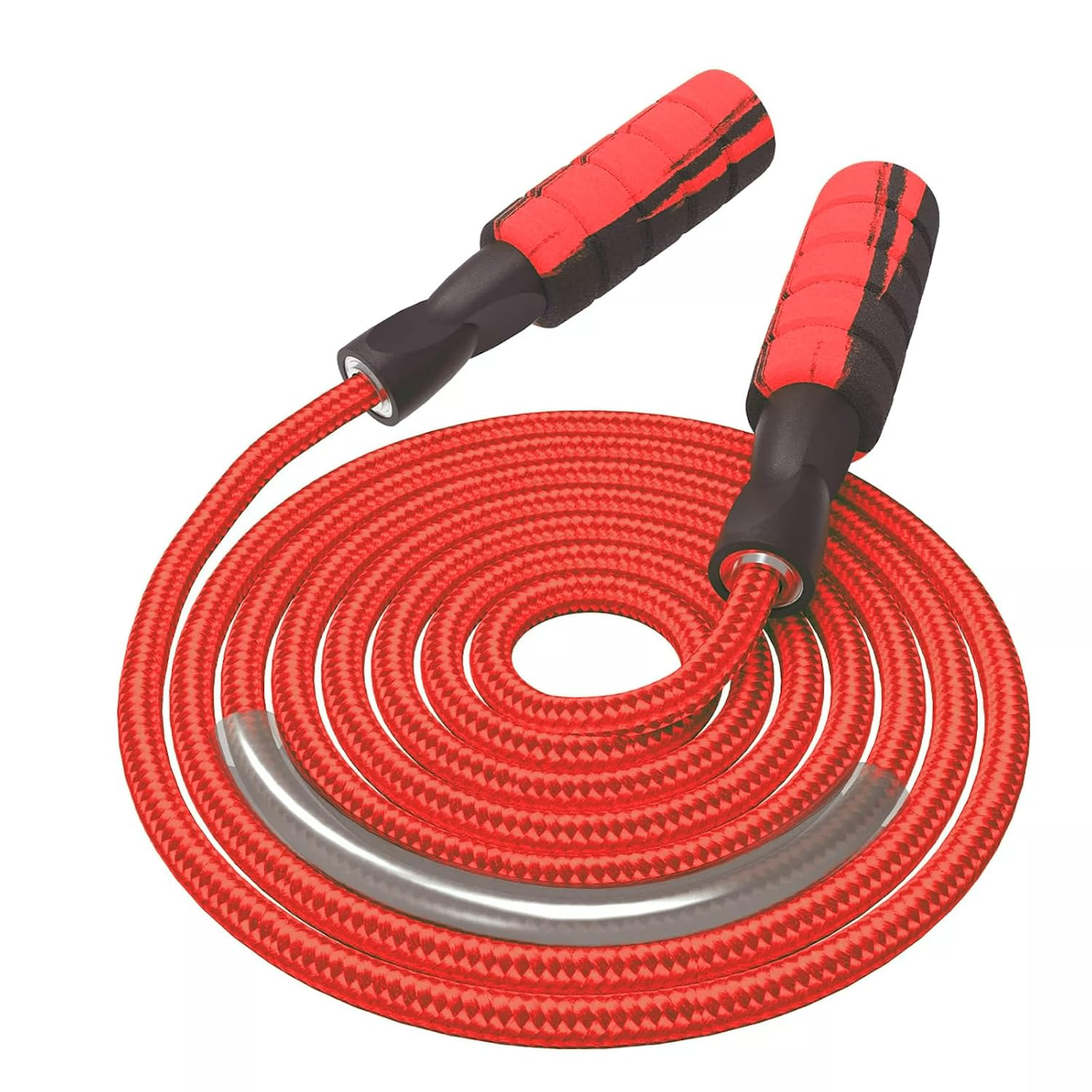
AP Weighted Skipping Rope
🔥 AP COTTON JUMP ROPE - Weighted Resistance Cardio Tool
Speed Ropes Build Quickness. Cotton Ropes Build Power Endurance.
Plastic speed ropes are for footwork and coordination. This cotton rope is heavier, thicker, and demands more from your shoulders, core, and cardiovascular system. It's not about how fast you can spin - it's about how long you can maintain intensity under resistance. This is conditioning work disguised as cardio.
Why Cotton Rope Training Is Different:
Heavier Rope = Greater Training Stimulus
A lightweight speed rope develops foot speed and coordination. A cotton rope forces your shoulders to work, your core to stabilize, and your cardiovascular system to adapt to sustained effort. Every rotation requires muscular engagement, not just momentum. This builds the power endurance that shows up in the fourth quarter when your competition is fading.
Used at Acceleration Performance for Conditioning Work
We use speed ropes for warmups and footwork drills. We use cotton ropes for conditioning blocks when we want to tax the entire system - shoulders burn, heart rate spikes, legs keep moving. Three minutes with a cotton rope equals six minutes with a speed rope in terms of training effect.
Old-School Tool, Undeniable Results
Boxers have used heavy cotton ropes for decades because they work. You can't fake your way through a cotton rope session. Either you have the conditioning or you don't. The rope exposes weaknesses and builds the resilience that matters in competition.
What Makes This Rope Work:
✅ Heavy Cotton Construction - Significantly heavier than plastic/wire ropes
✅ Adjustable Length - Customize for your height and training style
✅ Thick Diameter - Substantial feel, forces proper technique
✅ Durable Handles - Comfortable grip for extended sessions
✅ Resistance Training Effect - Builds shoulder endurance and core stability
✅ Natural Material - Cotton absorbs sweat, maintains grip
✅ Professional Grade - Built for serious training, not casual use
What You're Actually Training:
SHOULDER ENDURANCE:
Every rotation engages deltoids, traps, and rotator cuff. Three minutes feels like a shoulder workout because it IS a shoulder workout.
CARDIOVASCULAR CAPACITY:
Heart rate spikes and stays elevated. This builds the aerobic base that supports explosive efforts in competition.
CORE STABILITY:
Heavier rope requires more core engagement to maintain upright posture and rhythm. Your abs work the entire session.
GRIP STRENGTH:
Thicker handles and rope weight challenge grip endurance. Forearms burn, grip improves.
MENTAL TOUGHNESS:
Cotton rope sessions are uncomfortable. Pushing through builds the mental resilience that shows up when games get tough.
POWER ENDURANCE:
Not pure power. Not pure endurance. The hybrid quality that determines who dominates late in competition.
Perfect For:
🥊 Combat Sports - Boxers, MMA fighters, martial artists need this
🏀 Basketball Players - Conditioning for continuous movement sports
⚽ Soccer/Hockey - Build engine for shift-based explosive efforts
🏈 Football - Position-specific conditioning (skill positions especially)
💪 Functional Fitness - CrossFit, boot camps, HIIT training
🏃 Endurance Athletes - Cross-training for runners, cyclists
🎯 All Athletes - Universal conditioning tool for work capacity
🔥 Metabolic Conditioning - Fat loss and cardiovascular improvement
The AP Cotton Rope Protocol:
CONDITIONING BLOCKS (Primary Use):
Round Work (Boxing Style):
- 3 minutes on, 1 minute rest
- Repeat 3-5 rounds
- Maintain consistent pace, don't sprint out
- This builds the conditioning boxers are famous for
Interval Training:
- 30 seconds maximum effort
- 30 seconds active recovery (slow rope or rest)
- Repeat 10-15 rounds
- Pure conditioning torture, incredible results
EMOM (Every Minute on the Minute):
- Minute 1: 50 jump rope rotations
- Rest remainder of minute
- Repeat 10-15 minutes
- Shoulders burn, heart rate stays elevated
WARMUP USE (Secondary):
- 3-5 minutes continuous at moderate pace
- Gets blood flowing, shoulders loose
- Prepares body for explosive training
- Better than jogging for athletic warmup
FINISHER (Brutal):
- End of training session
- 100-200 rotations for time
- Or max rotations in 2-3 minutes
- Leave everything on the floor
Cotton Rope vs. Speed Rope:
SPEED ROPE (Lightweight Plastic/Wire):
Purpose: Footwork, coordination, speed
Training Effect: Cardiovascular (light), coordination (high)
Shoulder Work: Minimal
Best For: Warmups, skill work, double-unders
Difficulty: Easy to moderate
COTTON ROPE (This One):
Purpose: Conditioning, power endurance, toughness
Training Effect: Cardiovascular (high), muscular endurance (high)
Shoulder Work: Significant
Best For: Conditioning blocks, metabolic work, mental toughness
Difficulty: Moderate to brutal
Ideal Setup: Own both. Speed rope for skill, cotton rope for conditioning.
How to Adjust Length:
STEP 1: Stand on Rope Center
Place one foot on the middle of the rope.
STEP 2: Pull Handles Up
Extend handles toward shoulders.
STEP 3: Check Length
Handles should reach armpits to chest height (not shoulders).
STEP 4: Adjust if Needed
Most cotton ropes have adjustable handles - trim or tie off excess length.
Too Long: Rope drags on ground, slows rotation, trips you up
Too Short: Rope clips feet, interrupts rhythm, frustrating
Just Right: Smooth rotation, clears feet with 2-4 inches
Progressive Training Protocol:
WEEK 1-2: Build Base Tolerance
- 2-3 sessions per week
- 2-3 rounds of 2 minutes each
- Rest 90 seconds between rounds
- Focus: Complete the time, don't worry about pace
WEEK 3-4: Increase Volume
- 3-4 sessions per week
- 3-5 rounds of 3 minutes each
- Rest 60 seconds between rounds
- Focus: Maintain consistent pace throughout
WEEK 5-6: Add Intensity
- 4-5 sessions per week
- Interval work (30/30, 40/20 splits)
- Shorter rest periods (30-45 seconds)
- Focus: Push pace while maintaining form
WEEK 7+: Peak Conditioning
- 5-6 sessions per week
- Mix protocols (rounds, intervals, EMOM)
- Add as training finisher
- Focus: Mental toughness, don't quit